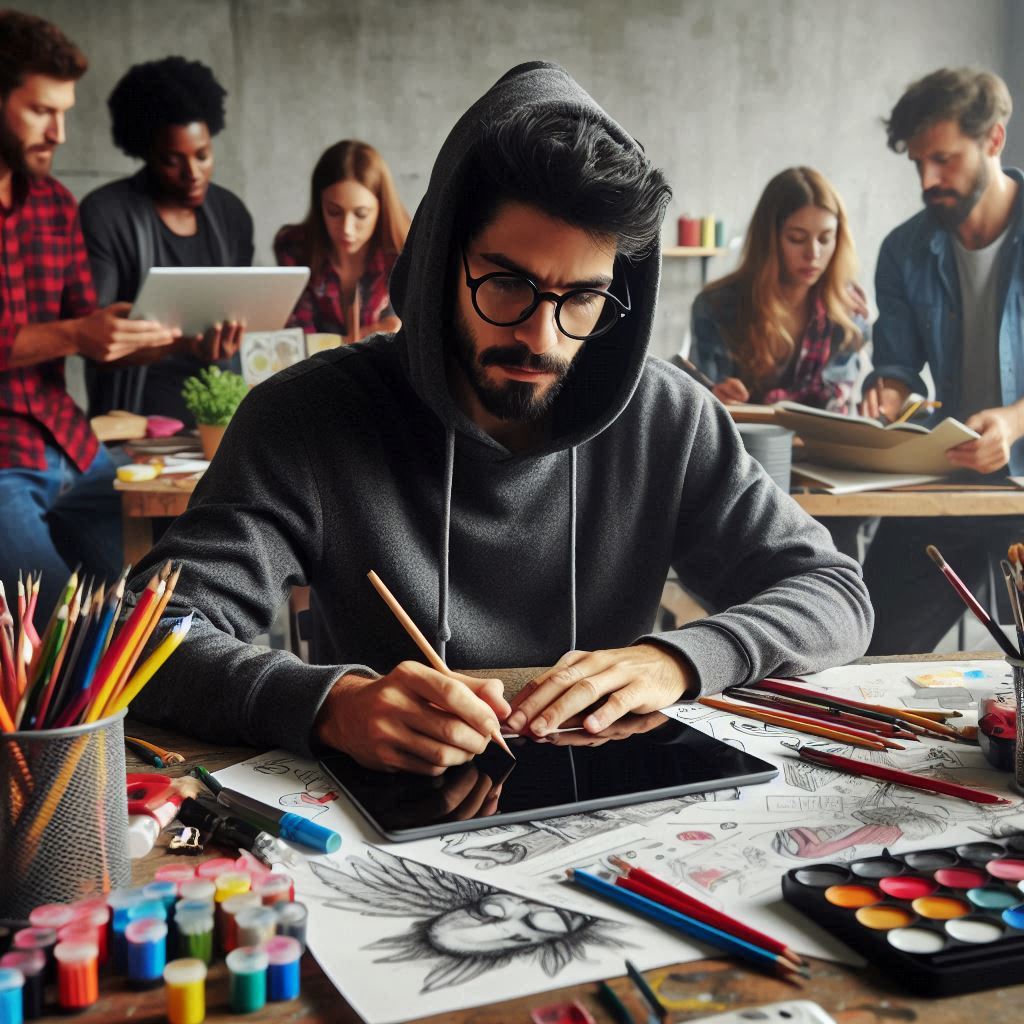Introduction
Concept art serves as a visual foundation for various creative projects, bridging the gap between imagination and reality.
It helps convey ideas and establishes a clear vision for what a project will ultimately become.
In industries like video games, movies, and animations, concept art plays a crucial role in guiding the creative process.
Artists utilize this medium to explore styles, characters, and environments before any final production takes place.
In video game development, concept art helps designers establish gameplay mechanics and user experiences.
Artists visualize characters, creatures, and settings, shaping the overall aesthetic of the game.
This initial artwork acts as a blueprint, ensuring that all elements align with the intended vision.
Similarly, in film, concept art significantly influences cinematography and production design.
It helps directors and producers communicate their ideas and align their visions with the entire creative team.
For animations, concept art is essential for character development and storyboarding.
Artists create dynamic visuals that breathe life into stories, illustrating movements and expressions.
These initial designs provide a cohesive visual language that informs every aspect of the production.
By enhancing collaboration among creative teams, concept art transforms abstract ideas into compelling visual narratives across all creative industries.
Ultimately, it lays the groundwork for successful projects and brings creative visions to life.
Understanding Concept Art Styles
Concept art plays a vital role in visual storytelling.
Artists use various styles to convey ideas effectively.
Understanding these styles enhances an artist’s versatility and adaptability.
This section discusses different styles of concept art, including realistic, stylized, and abstract approaches.
Different Styles of Concept Art
Realistic concept art focuses on lifelike representations.
Artists strive to create images that resemble real life.
This style often employs accurate anatomy, lighting, and textures.
Realistic art is essential in industries like film and video games.
It helps create believable worlds and characters.
Stylized concept art emphasizes artistic expression.
Artists exaggerate forms and colors to convey emotions or themes.
This approach allows for creativity and personal interpretation.
Stylized art often has a distinct visual identity.
Many animated films and games utilize this style to create memorable characters and environments.
Abstract concept art focuses on shapes, colors, and forms rather than realism.
Artists convey emotions or concepts through non-representational elements.
This style encourages viewers to interpret the artwork subjectively.
Abstract art is often used in conceptual stages to explore ideas without constraints.
Examples of Popular Concept Art Styles and Their Characteristics
Realistic Concept Art
Realistic concept art often includes detailed environments and characters.
Artists pay close attention to anatomy, perspective, and lighting.
For example, film concept art for “Avatar” showcases lifelike aliens and lush environments.
The use of color and shading creates depth and realism.
Stylized Concept Art
Stylized concept art is seen in productions like “The Legend of Zelda.”
Artists use exaggerated features and vibrant colors to create memorable characters.
The unique style sets the game apart, appealing to its audience.
This approach allows for a more playful and imaginative aesthetic.
Abstract Concept Art
Abstract concept art can be seen in works by artists like Paul Chadeisson.
He creates pieces that focus on mood and atmosphere.
By using geometric shapes and unusual color combinations, he evokes feelings without depicting reality.
This style is often used in initial brainstorming sessions to explore concepts freely.
Fantasy Concept Art
Fantasy art often blends realism and stylization.
It features mythical creatures, magical landscapes, and epic battles.
Artists like Brian Froud have defined this genre with intricate designs and imaginative worlds.
The characters often display unique clothing and accessories, enhancing the fantasy element.
Sci-Fi Concept Art
Sci-fi art explores futuristic technology and alien worlds.
Artists create environments filled with spaceships, advanced machinery, and otherworldly creatures.
Works like those seen in “Blade Runner” exemplify this style with intricate designs and atmospheric elements.
The art captures the imagination and showcases possibilities beyond our current reality.
Understanding different concept art styles is essential for any aspiring artist.
Each style has unique characteristics that serve specific purposes.
By exploring and mastering these styles, artists can create compelling visuals that resonate with their audience.
This versatility will enhance their skills and expand their creative horizons.
Embrace these styles to enrich your concept art journey.
Read: Visual Merchandiser: Job Market and Opportunities
Techniques Used in Concept Art
Concept art is a diverse field, utilizing various techniques to bring ideas to life.
Each technique plays a unique role in shaping the visual narrative.
Understanding these techniques can help artists select the best approach for their projects.
Various techniques used in creating concept art
Sketching
Sketching is often the first step in the concept art process.
Artists use traditional tools like pencils and pens to create rough drafts.
This technique allows for quick exploration of ideas and shapes.
It promotes spontaneity, enabling artists to capture inspiration as it strikes.
Sketching is invaluable for brainstorming and refining initial concepts.
Artists can easily make changes during the sketching phase.
They can adjust proportions, poses, and perspectives rapidly.
This flexibility encourages creativity and experimentation.
The fluidity of sketching fosters an environment where innovative ideas can flourish.
It serves as the foundation for more polished work.
Digital Painting
Digital painting is a popular technique in modern concept art.
Artists use software like Photoshop or Procreate to create intricate images.
This method combines traditional painting techniques with digital tools.
Digital brushes simulate real-world textures and effects, offering endless possibilities.
Digital painting allows for greater precision and control.
Artists can easily manipulate layers, colors, and effects.
This flexibility enables quick revisions, enhancing the creative process.
Artists can also use filters and effects to achieve desired aesthetics.
The speed of digital painting accelerates project timelines without sacrificing quality.
3D Modeling
3D modeling has gained popularity in concept art, especially for video games and films.
This technique involves creating three-dimensional representations of characters and environments.
Artists use software like Blender or ZBrush to construct detailed models.
3D models provide a comprehensive view of designs.
They allow artists to visualize forms, textures, and lighting in a realistic manner.
This technique enhances collaboration among teams by providing a tangible reference.
Designers can share models with animators and producers for feedback and adjustments.
3D modeling also streamlines the production process.
It enables artists to quickly iterate and refine designs based on feedback.
This efficiency is crucial in fast-paced environments like game development.
How different techniques can impact the overall look and feel of concept art
Different techniques significantly impact the overall look and feel of concept art.
For instance, sketching conveys raw, initial ideas, often with a loose, organic feel.
In contrast, digital painting can produce polished, vibrant images that evoke specific moods.
3D modeling provides realism and depth, creating immersive experiences.
The choice of technique can influence how audiences perceive characters and settings.
Each method brings its unique strengths, shaping the final visual narrative.
By understanding these techniques, artists can choose the best approach for their projects.
They can blend methods to create a rich and engaging visual experience.
Mastering these techniques allows artists to effectively communicate their ideas and captivate their audiences.
Read: Networking Events for Costume Designers
The Process of Creating Concept Art
Creating concept art is a structured process that guides artists from initial ideas to final visuals.
Each step is crucial in developing a cohesive and compelling piece.
Understanding this process can enhance your appreciation of concept art‘s role in creative projects.
Break down the step-by-step process of creating concept art
Ideation
The process begins with ideation.
Artists brainstorm ideas based on project requirements and themes.
They explore various concepts, considering elements like mood, style, and narrative.
This stage involves sketching rough thumbnails to visualize different directions.
Artists often create multiple iterations to capture the essence of their ideas.
Research
After ideation, artists conduct thorough research.
They gather references from real life, existing artworks, and relevant materials.
This research helps artists understand the subject matter, context, and historical influences.
They analyze textures, colors, and forms, which inform their designs.
This stage ensures the artwork remains authentic and believable.
Transform Your Career Today
Unlock a personalized career strategy that drives real results. Get tailored advice and a roadmap designed just for you.
Start NowSketching
Once research is complete, artists begin sketching.
They create more refined sketches based on their ideation and research.
These sketches focus on proportions, composition, and details.
Artists explore different angles and perspectives to find the most compelling representation.
Feedback from team members can be valuable at this stage, leading to further refinements.
Development
The next step involves development.
Artists select the strongest sketches and start developing them into more detailed illustrations.
They add color, texture, and lighting to enhance the visuals.
This stage may involve creating digital paintings or traditional illustrations.
Artists experiment with various techniques to achieve the desired look and feel.
Importance of collaboration between concept artists and other team members during the creation process
Collaboration plays a vital role throughout the concept art process.
Concept artists work closely with other team members, such as art directors, designers, and writers.
This collaboration ensures that the artwork aligns with the overall vision of the project.
Regular meetings and discussions foster a productive environment for feedback and ideas.
Team members provide valuable insights that shape the direction of the art.
The process culminates in final rendering.
Artists polish their work, refining details and enhancing the overall presentation.
They focus on achieving the desired quality and consistency in the artwork.
This final stage may include adjustments to color balance, contrast, and lighting.
The result is a polished piece ready for presentation or production.
The process of creating concept art is a multi-faceted journey.
From ideation to final rendering, each step plays a critical role in bringing ideas to life.
Collaboration among team members enhances the quality of the work and ensures a unified vision.
Understanding this process enriches your appreciation of concept art and its impact on the creative industry.
Read: Collaborating with Other Creative Roles

Explore Further: Packaging Design Awards: Prestigious Competitions
Tips for Aspiring Concept Artists
Tips and Advice for Individuals Who Aspire to Pursue a Career in Concept Art
Use references to improve accuracy and confidence in your work, as consistent practice will enhance your skills.
Exploring various art styles broadens your understanding and helps you find your unique voice.
Analyze the work of established concept artists and identify what you admire about their styles.
This exploration can inspire your own work and guide you in creating a personal style that reflects your interests.
Your portfolio serves as your calling card in the industry, showcasing your best work and demonstrating your skills to potential employers.
Ensure your portfolio features completed projects, concept sketches, and finished artwork, updating it regularly to keep it fresh and relevant.
Receiving constructive criticism from peers and mentors is essential for growth.
Share your work with fellow artists and be open to feedback.
Engaging with a community helps you stay motivated and inspired.
Networking can open doors in the concept art industry.
Attend events, conventions, and workshops to meet other artists and industry professionals.
Engage in online forums and social media groups dedicated to concept art.
Building relationships can lead to collaboration and job opportunities.
Follow industry blogs, YouTube channels, and podcasts that focus on concept art to keep abreast of the latest tools, techniques, and standards.
Investing in quality art tools that suit your workflow is also essential.
Traditional artists may need sketchbooks, pencils, and paints, while digital artists should consider graphic tablets and software like Adobe Photoshop or Procreate.
Familiarize yourself with various tools and find what works best for you.
Websites like Skillshare, Udemy, and Coursera provide access to courses on digital painting, character design, and more.
Platforms like ArtStation and DeviantArt also allow you to share your work and learn from others.
Platforms like Discord and Reddit have groups dedicated to concept art.
Resources and Tools That Can Help Aspiring Concept Artists Improve Their Skills and Build a Strong Portfolio
By following these tips, aspiring concept artists can build a solid foundation for their careers.
Regular practice, networking, and continuous learning will set you on the path to success.
With dedication and the right resources, you can thrive in the exciting world of concept art.
Read: Top Skills Needed for Art Educators and Instructors
Impact of Concept Art on Visual Storytelling
How Concept Art Plays a Crucial Role in Visual Storytelling and World-Building
Concept art serves as the foundation for visual storytelling and world-building in various media.
It helps convey the themes, emotions, and atmospheres of a narrative through imagery.
Concept artists visualize ideas, providing a clear direction for the entire production team.
Their work lays the groundwork for characters, environments, and key visual elements that shape the audience’s experience.
Effective concept art helps to establish a cohesive visual language for a project.
This consistency ensures that all elements work harmoniously, enhancing the storytelling experience.
Artists explore different styles, colors, and compositions to create moods that resonate with the audience.
For instance, a dark and moody palette might evoke feelings of tension, while bright colors can instill a sense of joy or adventure.
Additionally, concept art plays a vital role in world-building.
It creates immersive environments that transport viewers into new realms.
Detailed illustrations of landscapes, architecture, and creatures provide a glimpse into the world‘s lore and culture.
This rich visual backdrop allows audiences to understand the setting, further engaging them in the narrative.
Ways in Which Concept Art Influences the Visual Aspects of Movies, Video Games, and Animations
In the film industry, concept art influences character design, set design, and special effects.
Directors and producers rely on these visual interpretations to make decisions about the overall aesthetic.
For example, concept art can help define the tone of a film, guiding cinematography and lighting choices.
This collaboration ensures that the final product aligns with the original vision, creating a more compelling story.
In video games, concept art shapes the player‘s journey through the game world.
It defines character abilities, gameplay mechanics, and user interface elements.
Game designers use concept art to visualize everything from character animations to environment layouts.
This foundational work is essential for creating a cohesive gaming experience, as it establishes how players will interact with the game world.
Animation also heavily relies on concept art.
Animators use it to develop character designs and background art, guiding the animation process.
Concept art serves as a reference point for animators, ensuring that movement and expressions align with the original vision.
This attention to detail helps create memorable characters and visually stunning sequences that enhance the storytelling.
Moreover, concept art fosters collaboration between various departments in the production process.
It provides a common language for artists, designers, and directors to communicate their ideas effectively.
By sharing visual concepts, teams can align their efforts and work toward a unified goal.
This collaboration results in a more polished final product, with each element contributing to the overall narrative.
Concept art significantly impacts visual storytelling and world-building across various media.
Its role in establishing visual language, influencing character and environment design, and fostering collaboration is crucial.
As technology continues to evolve, the importance of concept art in shaping narratives will only grow, making it an integral part of the creative process.
Conclusion
In this blog post, we explored various concept art styles and techniques.
We discussed the characteristics of realistic, stylized, and abstract art.
Each style has unique features that contribute to storytelling.
Realistic art captures lifelike details, while stylized art emphasizes creative interpretations.
Abstract art challenges viewers’ perceptions, evoking emotions through unconventional forms.
Understanding these styles enhances your appreciation of concept art.
Each technique offers a different approach to visual storytelling.
By experimenting with various styles, artists can develop their unique voices.
This exploration fosters creativity and innovation in your work.
We encourage readers to actively explore diverse concept art styles.
Try your hand at realistic sketches or dive into abstract designs.
Analyze your favorite artworks to understand their techniques and inspirations.
Engaging with different styles expands your artistic toolbox, allowing for greater expression.
Ultimately, embracing a variety of concept art techniques will enrich your skills and knowledge.
This creative field constantly evolves, offering new opportunities for growth.
So, take the plunge, explore, and let your artistic journey unfold!
[E-Books for Sale]
The Big Book of 500 High-Paying Jobs in America: Unlock Your Earning Potential
$19.99 • 500 High-Paying Jobs • 330 pages
Explore 500 high-paying jobs in America and learn how to boost your career, earn more, and achieve success!
See All 500 High-Paying Jobs of this E-Book
1001 Professions Without a Degree: High-Paying American Jobs You Can Start Now
$19.99 • 1001 Professions Without a Degree • 174 pages
Discover 1001 high-paying jobs without a degree! Unlock career tips, skills, and success strategies for just $19.99!




